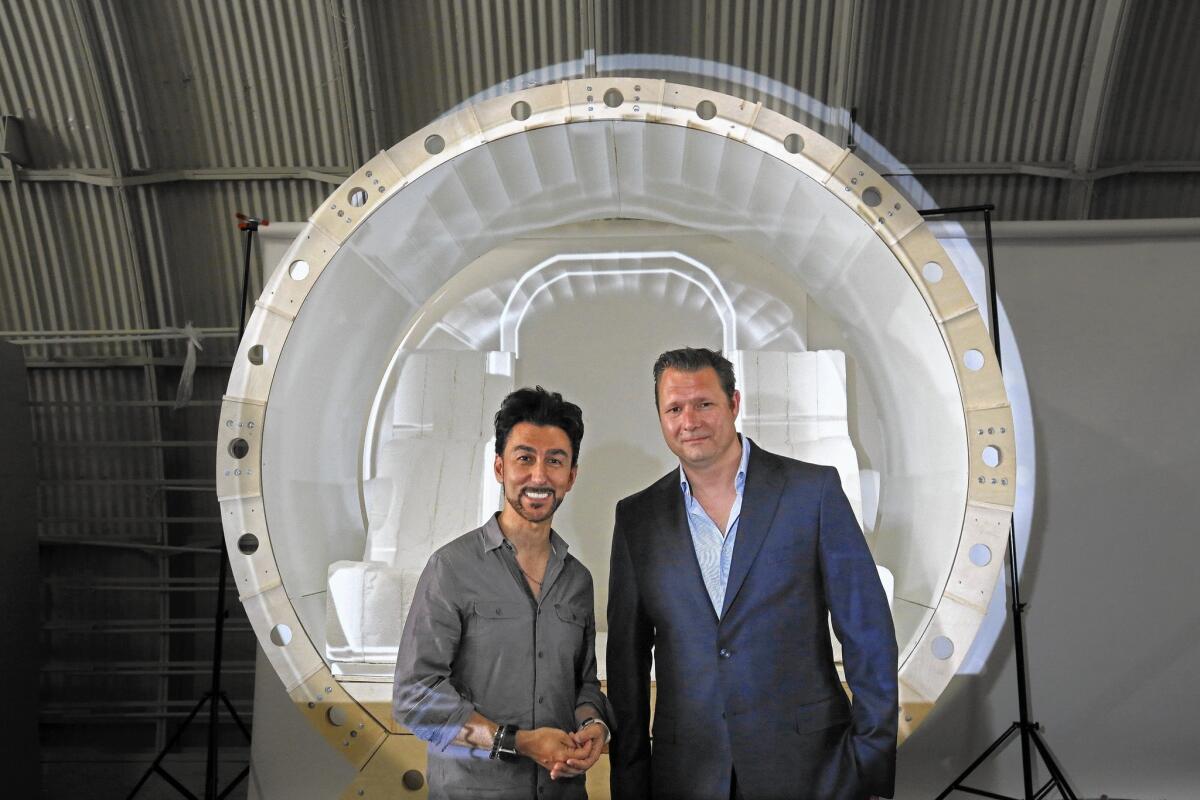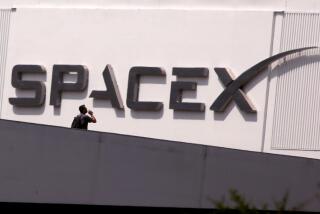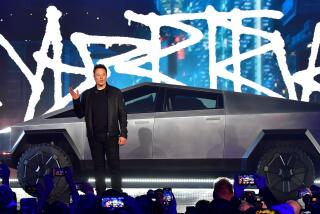Cutting Edge: How two L.A. start-ups are racing to develop transportation more amazing than self-driving cars

- Share via
Two Los Angeles start-ups are racing to develop tubes to zip people hundreds of miles an hour between cities — the so-called Hyperloop.
The plan was hatched by entrepreneur Elon Musk. Two years ago, the founder of Tesla and SpaceX, too busy with other matters to develop the one form of transportation that sounds more amazing than self-driving cars, opened up his plans and invited the wider world to pick up the project.
Two of the companies that took up the offer — Hyperloop Transportation Technologies Inc. in Playa Vista (HTT) and Hyperloop Technologies Inc. (HT) in downtown’s Arts District — have the same goal but their approach to management could hardly be more different. In a sense, it’s also a race to prove which management style works best.
HTT is the radical company, taking a crowdsource approach to its Hyperloop design and development by tapping as many bright minds as possible. Most of its 420 workers serve part-time, as online contractors without salaries.
HT in the Arts District is more traditional. More than 50 full-time employees work at its three-acre campus. It’s raising large sums of cash from Silicon Valley venture capital titans and attracting big-name advisors, including a former President Obama campaign manager and a former Snapchat executive.
“I’m a firm believer that this is going to take amazing full-time talent, resources and capital,” Chief Executive Rob Lloyd said.
Who progresses fastest will determine the future of the Hyperloop. And HTT’s unconventional structure, if it works, could become a model for other industries. Or it could flop, as just another expensive, one-time hobby project.
NEWSLETTER: Get the day’s top headlines from Times Editor Davan Maharaj >>
To HTT, collaboration is the best way forward.
“We weren’t understanding the position of Elon: Why would a man with the vision not do it himself?” said Bibop Gresta, the company’s chief operating officer. “The answer came immediately after: To do this, you need the best minds in the planet. You’ve never had the best engineers from NASA working with the best engineers from Tesla, Boeing and so on.”
But first, what are Hyperloops? They are transportation tubes, in which people and goods would travel hundreds of miles in train-car-sized capsules, propelled by electricity, magnetism and air pressure. The tubes would suck the capsules, suspended in air, almost like a vacuum cleaner. Travel time from Los Angeles to San Francisco? Half an hour, according to Musk.
With renewable energy sources and the novel design, Hyperloops promise to be more resource-efficient and faster overall than car, plane or train. Musk contends even electric cars and high-speed rail would be outmatched — if the idea works.
To prove the theory, HTT plans to construct a test tube in Quay Valley, a solar-powered community being built near Kettleman City, Calif.
Within the first six months of the project launching online, more than 200 online applicants sought to help HTT.
Building a flexible workforce was the idea of HTT Chief Executive Dirk Ahlborn, 38, a German-born entrepreneur, who’s long advocated crowdsourced, online management. The people he chose work at NASA, SpaceX, Tesla, Cisco, Boeing, Google, Microsoft and other tech and engineering companies. A few ask permission before accepting the side gig, but no outside companies have raised concerns, Ahlborn said.
People are arranged into teams of five to nine. Four teams tackle pillar designs. Five study power sources such as solar and nuclear. Several address comfort, storage and assembly of passenger capsules.
The workforce is forgoing paychecks in favor of stock options that vest over several years. They’ll have the chance to purchase HTT shares at a discount, perhaps as early as this fall. Amid soaring valuations of technology start-ups, workers are gambling that the venture is big enough to produce future riches.
For Ahlborn and Gresta, the system is valuable too. Budget constraints often require companies to reject high-caliber candidates. But HTT can tap alternates, even if for limited durations.
“Do you want the head of engineering from Boeing for two hours or an average engineer for two weeks?” Gresta said.
Greg Henk, who’s managed transportation projects nationwide and now works for Ahlborn, said having more people increases collective imagination at the crucial conceptual phase.
“It’s a big deal in how we do business,” he said.
Similar setups are common at software companies. But its adoption at a multifunction engineering company is “cutting edge,” said Terri Griffith, chair of the management department at Santa Clara University’s Leavey School of Business.
Assuming everyone’s on the same page, “this is both the organizational design of the future and likely to be very effective,” she said.
Teams are led by a hypermaster — typically a natural leader. They collaborate through email, online file sharing apps and videoconferencing software. They hold weekly phone calls and respond to automated queries about their progress. Hypermasters report to a hypermanager who coordinates information-sharing between teams.
A probation period, called limbo, lets newbies earn their keep by solving a problem of their choosing and one assigned to them. People do drop out; 20 people have already left.
The big workforce enables deep consideration of competing solutions. One tube material team analyzes carbon steel, for example, while others look at carbon fiber, carbon concrete and ultra-high-performance concrete.
The competition also acts as a hedge against workers becoming subservient to hypermasters and the suffocation of different ideas.
“Engineering is like a religion — when someone starts to pray, everyone prays in the same way,” Gresta said.
People must spend at least 10 hours a week on Hyperloop tasks, though some reach 70 hours. Hours convert to stock options and theoretically improve the company’s prospects.
Art Hadnett, West division president of engineering firm HNTB, said maintaining consistency and engagement to prevent teams from coming “off the rails” will be a challenge.
“While the initial thinking might be phenomenal, if it’s not there at the end game you could run into trouble,” he said. Still, he shares the excitement about HTT’s crowdsource experiment.
HTT is hiring some full-time managers as the construction phase nears. Employee No. 1, Yayun Zhou, 24, graduated with a master’s degree in architecture from UCLA in June. She had worked on the Hyperloop station design in architect Craig Hodgetts’ class. Now, she’s collaborating with people worldwide.
On a recent morning inside a former Hughes Aircraft hangar in Playa Vista, Zhou and others edited videos, showed off tiny Hyperloop station models and organized the new office. Labs nearby, including at Microsoft Corp., also serve as workspace.
Engineering giant Aecom and Swiss technology company Oerlikon are providing product and regulatory expertise. They receive “modest” stock options and insights into new workflows, officials said. Aecom expects as many as 100 employees to work on Hyperloop tasks.
HTT says the Quay Valley test will cost $150 million. Sponsors, venture capitalists, foreign governments and individual investors could be funding sources. HTT plans to recoup some costs by considering how every piece of a Hyperloop could make money. Columns, for one, could be outfitted with solar panels or billboards. Ahlborn says several pairs of cities are interested in buying future Hyperloops if the Quay Valley test succeeds.
His bigger goal is to apply the HTT structure to energy, food and other industries, redefining how companies form. Today, it’s two friends at a bar with beers and a napkin.
“This process is taking advantage of the Internet, reaching the best people wherever they are,” he said. “For us, it’s, ‘Are you passionate about the project? OK, come help us.’”
Twitter: @peard33
ALSO
Why Dollar Shave Club invests in unscripted customer service
India’s Narendra Modi to chat with Facebook and dine with Google
TwitchCon: Twitch uses its first user convention to unveil features rivaling YouTube







